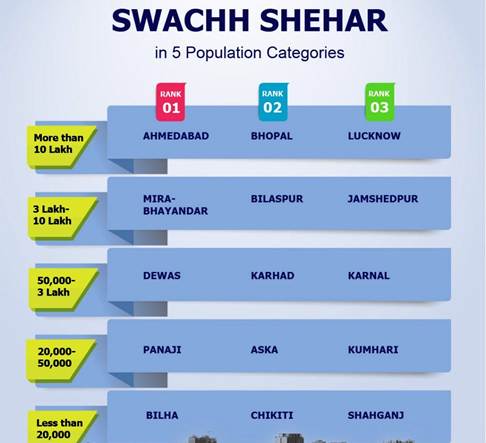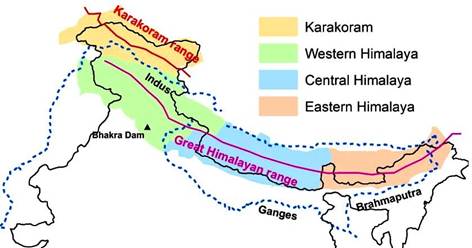Content :
- Swachh Survekshan 2024-25 Awards
- Complex greenhouse gas dynamics in the Central Himalayas revealed
Swachh Survekshan 2024-25 Awards
Introduction & Background
- Swachh Survekshan is the world’s largest urban sanitation survey, conducted annually by the Ministry of Housing and Urban Affairs (MoHUA) under the Swachh Bharat Mission–Urban (SBM-U).
- Launched in 2016, the survey evaluates cities on parameters like waste management, sanitation, citizen feedback, and innovation.
- 2024–25 marks the 9th edition, with a sharper focus on inclusivity, circular economy, and city-to-city mentoring.
- This edition commemorates 10 years of Swachh Bharat Mission (2014–2024), showcasing India’s transformative journey in urban cleanliness.
- The revamped framework in 2024–25 introduced:
- 10 new indicators
- 5 city-size categories
- Equal opportunity for smaller cities to compete with metros.
Relevance : GS 1(Indian Society ) , GS 2 ( Governance & Policy Implementation )

Top Awards & Recognitions
- Indore, Surat, Navi Mumbai entered the Super Swachh League, the topmost tier for cleanliness.
- Ahmedabad, Bhopal, Lucknow declared India’s New Clean Cities.
- 43 National Awards presented across categories.
- Mahakumbh 2024 (66 crore footfall) received special recognition for urban waste management.
Special Category Winners
- Best Ganga Town: Prayagraj
- Best Cantonment Board: Secunderabad Cantonment
- Best SaafaiMitra Surakshit Shehar (Worker Safety):
- GVMC Visakhapatnam
- Jabalpur
- Gorakhpur
Promising Clean Cities
- 34 cities (1 from each State/UT) awarded under the ‘One City, One Award’ framework.
- Created a level playing field for smaller towns with simplified scoring parameters.
New Initiatives Launched
- Swachh City Partnership:
- 78 top-performing cities to mentor 78 low-performing cities.
- Promotes peer learning, handholding, and accountability.
- Motto: “Each one clean one”.
- Accelerated Dumpsite Remediation Program:
- Launch Date: 15 August 2025
- Duration: 1 year
- Goal: Remediate legacy waste, reclaim urban land, and enhance scientific processing capacity.
Framework Enhancements
- Revamped assessment model:
- Introduced 10 new evaluation parameters
- Five distinct population categories to ensure fair competition.
- Simplified process enabled small cities to compete with metro cities.
Presidential Address – Key Messages
- Emphasized 3R Principle: Reduce, Reuse, Recycle
- Highlighted role of waste-to-wealth innovations, including the circular economy model.
- Applauded initiatives:
- Zero-waste colonies
- School-based interventions
- Segregation startups
- “Swachhata is now part of our swabhav and sanskaar.”
- Envisioned a Viksit Bharat 2047 that leads the world in cleanliness.
Impact & Vision
- 10 years of Swachh Bharat Mission celebrated.
- Urban sanitation is now deeply integrated into public life and governance.
- Next focus: A long-term strategy aligned with Viksit Bharat @2047 roadmap.
Other Notables
- Launch of Swachh Survekshan Dashboard for real-time rankings and performance.
- Artistic sarangi made from waste gifted to the President — symbolizing sustainability meets culture.
Complex greenhouse gas dynamics in the Central Himalayas revealed
Introduction & Background
- First high-resolution, continuous ground observations of key greenhouse gases in the Central Himalayas, conducted by ARIES-Nainital (under DST, GoI).
- Study fills a critical data gap in mountain regions of South Asia, previously underrepresented in global climate datasets.
- Observations span 5 years (2014–2018) from a high-altitude station in Nainital.
Relevance : GS 1(Geography) ,GS 3(Environment and Ecology)
Key Greenhouse Gases Monitored
- Carbon dioxide (CO₂)
- Methane (CH₄)
- Carbon monoxide (CO)

Major Findings
- CO₂ & CH₄ concentrations are rising steadily:
- CO₂: +2.66 ppm/year
- CH₄: +9.53 ppb/year
- Higher than Mauna Loa (a global background station)
- CO shows a declining trend: –3.15 ppb/year
- Suggests improved combustion efficiency or emission shifts.
- Concentration levels in the Central Himalayas:
- Higher than other remote sites (due to regional/local sources)
- Lower than urban/semi-urban areas
Diurnal & Seasonal Patterns
- CO₂: Lowest during daytime due to active photosynthesis
- CH₄ & CO: Peak during daylight, transported by upslope mountain winds
- Spring:
- CO₂ spikes due to biomass burning and bare vegetation
- Autumn:
- CH₄ peaks linked to rice cultivation (agricultural emissions)
- Late Spring:
- CO peaks suggest regional transport from fires/pollution
Meteorological Influences
- Solar radiation, temperature, and boundary layer height significantly shape GHG patterns.
- Data reveals interactions between biospheric uptake, regional emissions, and complex mountain meteorology.
Global & Policy Relevance
- Supports validation of satellite climate data over Himalayan region.
- Enhances climate models and GHG emissions inventories for India.
- Aids localised mitigation policies in ecologically sensitive zones.
- Aligns with India’s National Action Plan on Climate Change (NAPCC) and SDG 13: Climate Action.
Scientific Significance
- Provides baseline for long-term Himalayan climate monitoring.
- Valuable for forecasting climate patterns, early warning systems, and carbon budgeting.
- Empowers policymakers with real-time, regional climate insights.
Value Addition :
1. Scientific & Global Significance
- Fills a Global Monitoring Gap: The Central Himalayas were previously a blind spot in the global GHG network.
- Enhances India’s contribution to WMO’s Global Atmosphere Watch (GAW) and IPCC datasets.
- Strengthens South-South Cooperation in climate science by building regional data ecosystems.
2. Data-Driven Insights for Mitigation
- Local CH₄ spikes in autumn → scope for methane mitigation in rice cultivation (e.g., alternate wetting & drying).
- CO trends → can feed into National Carbon Markets, informing emission baselines.
- Seasonal biomass burning data → helpful for pre-emptive policy action during fire seasons (e.g., stubble management).
3. Satellite + Ground Data Integration
- These observations can validate ISRO’s climate monitoring satellites like Megha-Tropiques and INSAT-3DR.
- Supports integration with Copernicus, MODIS, and GHGSat global datasets for cross-verification.
4. Alignment with SDGs & Global Commitments
- SDG 13 (Climate Action) → Enhancing resilience through real-time data.
- Supports India’s 2021 Updated NDC Targets (e.g., net zero by 2070).
- Promotes Just Transition in mountain regions by linking emissions to socio-economic activity (e.g., agriculture, tourism).
5. Potential Follow-up Research & Policy Needs
- Need for multi-site Himalayan observation networks (e.g., in Sikkim, Arunachal, Himachal).
- Integration with ICIMOD regional programs for transboundary data sharing.
- Policy suggestion: Inclusion of GHG hotspots in India’s State Climate Vulnerability Index.



